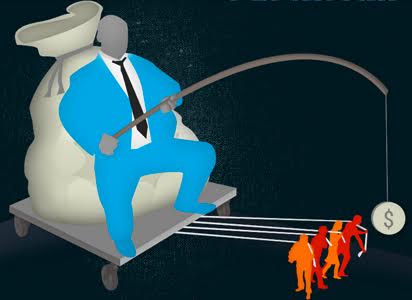
In two major moves towards corporate accountability to everyone else, states and cities are being urged to disclose total tax subsidies to corporations, and whether they succeed. And a top federal agency is imposing corporate disclosure on pay ratios between CEOs and median workers’ pay.
The Governmental Accounting Standards Board‘s rule about the tax breaks and their value – or lack of it – kicks in next year. The federal Securities and Exchange Commission‘s rule about CEO pay will take effect after a comment period.
Disclosure of such tax breaks, and of the CEO pay, have been top goals of workers and their allies who have campaigned for years for more corporate accountability.
Union-supported Good Jobs First, a non-profit organization, has compiled its own data about the tax breaks for several years. But the accounting board’s rule also demands a comparison of job-creation promises to actual job creation.
State and city governments ladle out billions of dollars yearly in tax subsidies, tax forgiveness and other tax breaks to attract or retain corporations, sometimes in a “race to the bottom” with each other. Some recent, and at times, outrageous, examples include:
- $250 million in Wisconsin state tax breaks to help pay for constructing the new $500 million arena for the Milwaukee Bucks basketball team. The multimillionaire owners are kicking in $150 million and former owner Herb Kohl, a retired Democratic U.S. senator and owner of Kohl’s, is adding $100 million. Right wing Gov. Scott Walker, R-Wis., known for smashing unions and slashing education spending, signed the tax break law on August 12. He needed Democratic support for it after some right wing Republicans in the GOP-legislature rebelled.
- Last year, New York governments promised $10 million in subsidies to Time, Inc., if it would keep its jobs in Manhattan – by shifting them from midtown to downtown – rather than moving them to New Jersey. Time agreed, but exacted a price: Cutting 900 of the 2,917 jobs. It didn’t tell the union for those workers, the New York Newspaper Guild, which filed a complaint with the National Labor Relations Board over failure to bargain the issue.
- In a desperate attempt to keep Boeing jobs in the Puget Sound area, Washington state enacted hundreds of millions of dollars in tax subsidies to the aircraft manufacturer.
- Chicago channeled $372 million to nearly 150 special taxing districts in 2014, or $1 for every $13 of property taxes billed in the city, according to figures from the Cook County clerk’s office, which collects city taxes.
- Belleville, Ill., just east of St. Louis, sent $15.6 million of its tax receipts, or about one of every six dollars it took in, to 19 special taxing districts that benefited developers of shopping centers and homes.
“Tax abatement programs are highly prevalent in the U.S.,” the accounting board said. They’re also “an issue of concern among citizen groups, county board members, and municipal bond analysts, and that each group desires to receive information about the level of abatement activity and the results of the abatement programs.”
But only six of the 44 states with tax-abatement programs require the firms that get the subsidies to report on the results. And 14 states have requirements for “clawbacks” of subsidies if the firm that got the tax break closed or moved. That happened in Connecticut last year, and the subsidy became an issue in that state’s governors’ race.
“Constituents have periodically raised the possibility of a pronouncement requiring governments to disclose additional information about tax abatements. At present, generally accepted accounting principles do not require state and local governments to disclose information related to tax abatements,” the accounting board said. That will change, it adds.
The Securities and Exchange Commission adopted its rule about executive pay-median pay ratios by a 3-2 party-line vote. The rule, originally ordered by the Dodd-Frank financial reform law, was delayed for years by fanatic corporate lobbying against it. Labor strongly supports the disclosure, lobbied for it, and hailed the SEC’s decision.
“We are pleased the SEC took action and recognized the difficult task the commission undertook as it came under numerous attacks by corporate interests,” said AFL-CIO President Richard Trumka.
“The rule will provide important information about companies’ compensation strategies and allow shareholders to determine whether CEO pay is out of balance in comparison to what a company pays its workers. We believe investors deserve transparency,” he said.
The federation has tried to provide that transparency about executive pay for the last decade or more, through its Executive PayWatch website and annual publication of executive compensation at the largest corporations. The SEC rule goes farther, though since it forces firms to disclose not just CEOs’ compensation but median pay, company by company.
Thus the pay of McDonald’s CEO, for example – around $9 million – would be compared to the median pay of McDonald’s workers, most of whom earn barely more than the minimum wage.
“We hope this rule will help investors make sound decisions when they vote on executive compensation packages,” Trumka added. “However, we are concerned it contains weaknesses that could be exploited to allow companies to avoid reporting the median income of all workers. The Dodd-Frank Act was meant to protect investors and ensure that our economy works for all.”
Photo: Executive PayWatch










